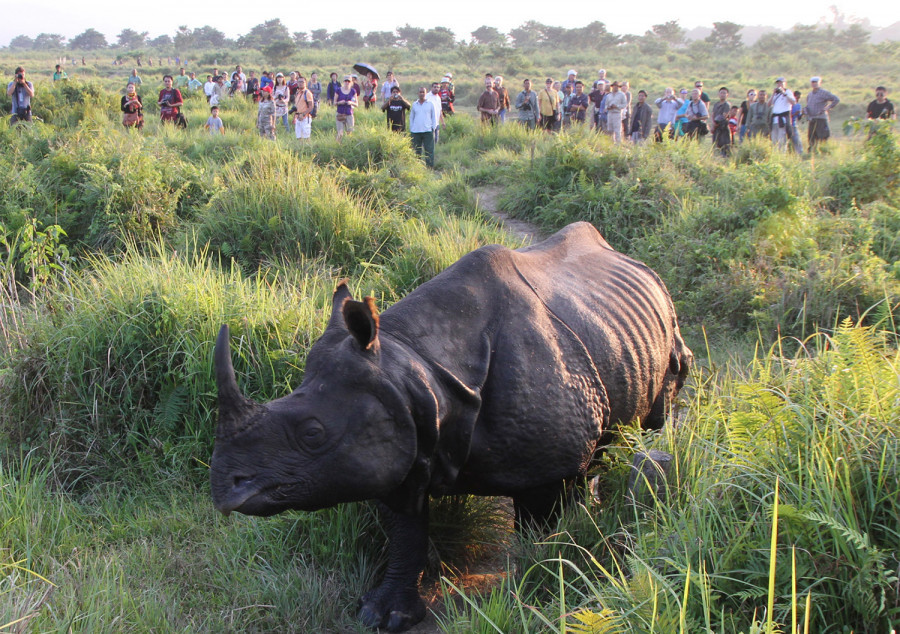National
Nationwide rhino census to begin from March 22
The much-awaited rhino count, which has seen multiple postponements since 2019, will be looked at carefully for its findings will guide the future interventions for rhino conservation as the country has lost a large number of rhinos in the period.
Chandan Kumar Mandal
The much-awaited rhino count is finally set to take place later this month.
A meeting of the advisory committee formed to oversee the rhino census on Sunday decided to conduct the count in the country’s national parks in southern plains from March 22.
According to Haribhadra Acharya, spokesperson for the Department of National Park and Wildlife Conservation, the main body responsible for conducting rhino census, the count will continue for three weeks.
“Before going to the field for the census, there will be training and orientation for those involved in the counting,” said Acharya. “The training will begin a couple of days before the counting date.”
The rhino count will begin from Chitwan-Parsa Complex, the block combining Chitwan National Park and Parsa National Park. It will then continue in a phase-wise manner in other protected areas—Bardiya National Park and Shuklaphanta National Park.
Authorities hope to conclude the census in all four park areas by April 11.
“The plan is to conclude the census within three weeks. It could take a few days more or less, because we expect that more time and efforts will be required to count the rhinos in Chitwan.”
Chitwan National Park is home to the biggest rhino population in the country.
As per the latest census of 2015, which had put Nepal’s rhino population at 645—605 rhinos were in Chitwan National Park, 29 in Bardiya National Park, eight in Shuklaphanta National Park, and three in Parsa National Park.
The rhino count in Bardiya is scheduled to begin on March 30 and is expected to be completed within 10-12 days. In Shuklaphanta, the census will start on April 1 and it will take at least one week for the enumerators to count the rhino population in the park.
The new date for the census was finalised after the advisory committee, which consists of government officials, wildlife experts and representatives from conservation partners, instructed the park authorities to clear grassland for counting rhinos and make other required arrangements.
The logistical preparation for the rhino count, which was earlier scheduled for 2019, had started last year. But just days ahead of the scheduled count, the census was called off due to the Covid-19 pandemic and could not take place in 2020, finally pushing the count for this year.
For conducting the count this season, which is considered the best timing for the rhino census, the government has allocated Rs8 million, though the entire process is expected to cost more than Rs10 million.
“Although rhino count could not take place last year, nearly Rs2 million was spent on buying equipment and other items. They can be used this time,” said Acharya. “The budget for the census has primarily come from the government. We have also received financial and technical support from our conservation partner agencies.”
For enumerating rhinos in protected areas and adjoining forests, park officials, technical experts, representatives of partner organisations and Nepal Army personnel, as well as elephants, will be mobilised. A counter mounted on elephants will also perform the headcount of rhinos inside national parks.
A total of 200 people and 60 elephants—40 in Chitwan and 10 each in Bardiya and Shuklaphanta— will be involved in the census taking process.
Authorities plan to release the findings of the rhino census within a week of completing the count on the ground.
The census results will be carefully studied as the country has lost a significant number of rhinos since the last count and also because the count is taking place after a gap of six years.
“We cannot make any estimate on the state of the rhino population right now. It will be known after the census,” said Acharya.
He believes the findings of the census will be crucial for devising future conservation plans for rhinos in the wake of natural deaths of rhinos in recent years.
Starting from the fiscal year 2016-17, when 25 rhinos were reported dead, including one killed by poachers, there has been an unprecedented surge in rhino deaths.
Twenty-six rhinos died in the fiscal year 2017-18, 43 in 2018-19, and 26 in 2019-20. Nearly two dozen rhinos have been found dead so far this fiscal year, leaving conservationists worried.
“The flood of 2017 might have killed some rhinos and there have been other rhino deaths since then. The rhino population is also determined by their birth, death and migration like that of humans,” Acharya said. “The census will also find out their status and distribution, giving insights on their habitats and their concentration.”
A team of wildlife experts—part of the team formed to investigate the increasing deaths of one-horned rhinos in Chitwan, have suggested internal relocation of rhinos as one of the measures to save the rhino population.
“If the rhino population is concentrated mainly in one area, they can be translocated elsewhere in order to redistribute their population,” said Acharya. “For the decision-making process of adopting such measures, we need information on rhino status. The census can support with the information required for managing the rhino population and their habitat.”




 13.12°C Kathmandu
13.12°C Kathmandu















